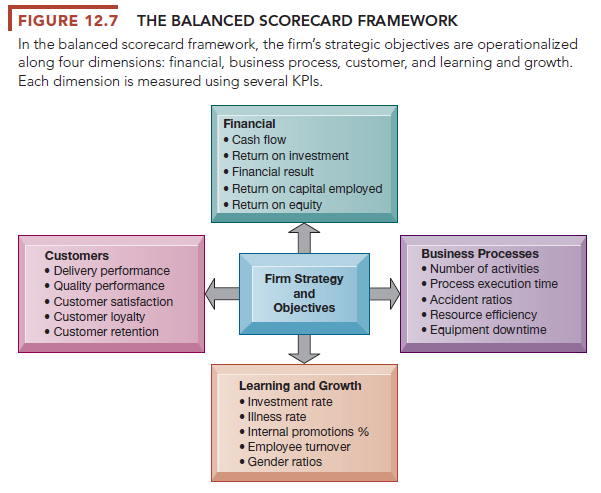The purpose of executive support systems (ESS), introduced in Chapter 2, is to help C-level executive managers focus on the really important performance information that affects the overall profitability and success of the firm. There are two parts to developing ESS. First, you will need a methodology for understanding exactly what is “the really important performance information” for a specific firm that executives need, and second, you will need to develop systems capable of delivering this information to the right people in a timely fashion.
Currently, the leading methodology for understanding the really important information needed by a firm’s executives is called the balanced scorecard method (Kaplan and Norton, 1992, 2004). The balanced scorecard is a framework for operationalizing a firm’s strategic plan by focusing on measurable outcomes on four dimensions of firm performance: financial, business process, customer, and learning and growth (Figure 12.7).
Performance on each dimension is measured using key performance indicators (KPIs), which are the measures proposed by senior management for understanding how well the firm is performing along any given dimension. For instance, one key indicator of how well an online retail firm is meeting its customer performance objectives is the average length of time required to deliver a package to a consumer. If your firm is a bank, one KPI of business process performance is the length of time required to perform a basic function like creating a new customer account.

The balanced scorecard framework is thought to be “balanced” because it causes managers to focus on more than just financial performance. In this view, financial performance is past history—the result of past actions—and managers should focus on the things they are able to influence today, such as business process efficiency, customer satisfaction, and employee training. Once a scorecard is developed by consultants and senior executives, the next step is automating a flow of information to executives and other managers for each of the key performance indicators (see the Interactive Session on Management). Once these systems are implemented, they are often referred to as ESS.
Another closely related popular management methodology is business performance management (BPM). Originally defined by an industry group in 2004 (led by the same companies that sell enterprise and database systems like Oracle, SAP, and IBM), BPM attempts to systematically translate a firm’s strategies (e.g., differentiation, low-cost producer, market share growth, and scope of operation) into operational targets. Once the strategies and targets are identified, a set of KPIs are developed that measure progress toward the targets. The firm’s performance is then measured with information drawn from the firm’s enterprise database systems. BPM uses the same ideas as the balanced scorecard but with a stronger strategy flavor.
Corporate data for contemporary ESS are supplied by the firm’s existing enterprise applications (enterprise resource planning, supply chain management, and customer relationship management). ESS also provide access to news services, financial market databases, economic information, and whatever other external data senior executives require. ESS also have significant drill-down capabilities if managers need more detailed views of data.
Well-designed ESS help senior executives monitor organizational performance, track activities of competitors, recognize changing market conditions, and identify problems and opportunities. Employees lower down in the corporate hierarchy also use these systems to monitor and measure business performance in their areas of responsibility. For these and other business intelligence systems to be truly useful, the information must be “actionable”—it must be readily available and also easy to use when making decisions. If users have difficulty identifying critical metrics within the reports they receive, employee productivity and business performance will suffer.
Source: Laudon Kenneth C., Laudon Jane Price (2020), Management Information Systems: Managing the Digital Firm, Pearson; 16th edition.

21 Jun 2021
21 Jun 2021
19 Jun 2021
21 Jun 2021
21 Jun 2021
21 Jun 2021